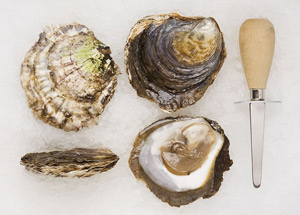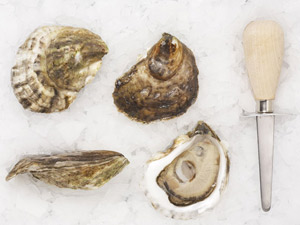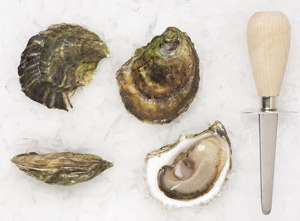September 2009
Guide to Maine Oysters
 Bagaduce
Bagaduce
[From J.P.’s Shellfish]
I always like to introduce a new product to our stable…One of our more recent additions is the Bagaduce oyster (Crassotrea virginica). This premium oyster is sourced through the brackish waters of the reversing falls of Bagaduce River (N 44.38/W 68.82), which is located in mid-coast Maine. So what makes the Bagaduce oysters so remarkable? I’m glad you asked! Our Bagaduce oysters are grown out in floating ADPI bags which place the oysters in the direct rays of the sun for the entire grow-out process, thereby thickening and strengthening the shell of the oyster…As an aside…You’ll be hard pressed to find a more aesthetically pleasing oyster…The shells of the Bagaduce oysters are the color of alabaster, and are virtually free of any bio-fouling. The wash of the tides keeps the oysters in constant motion, and a natural manicuring process takes place, where the thin new shell growth is chipped away, thereby promoting greater cup definition. You’ll find our Bagaduce River oysters to possess an exceptional level of congruity, especially for an oyster of this size. Producing a small (cocktail) oyster that is cookie-cutter consistent is impressive…But producing a large choice oyster with such terrific consistency is really quite a trick. As an oyster grows, so do the odds that there will be a greater degree of variance in size, shape, and cup definition….Especially if the oysters in question aren’t manicured by hand. By utilizing the aforementioned ADPI bags, gentle friction is created as the other oysters chafe against each other, as well as the hard-plastic mesh that houses them. Kind of like a rock tumbler, only not nearly as abrasive. After two-and a half to three years, the resulting three to four inch oysters are some of the finest you’ll find anywhere. Meats are full, and don’t get lost inside the large shells. Check the salinity, it don’t change; Stays 28 (ppt), come shine or rain! That’s right. 12 months a year. The many levels of consistency associated with this oyster are truly amazing. Did I mention that our partners at the Bagaduce River Oyster Company haven’t missed fishing an open harvest day in eight years? What more can I say to encourage you to try these oysters???
Oh yeah…The Bagaduce oysters have recently been featured at a couple of dinners at The James Beard House, and are reputed to be a favorite of Thomas Keller. I’m not typically one to drop names…But in this case…I simply can’t resist. How’s that for instant credibility?
 Belon Oysters (Ostrea Edulis) – Maine or Nova Scotia
Belon Oysters (Ostrea Edulis) – Maine or Nova Scotia
[From Pangea Shellfish and Seafood Company]
Geography – Our Maine belon oysters grow in the cold waters of the Damariscotta River, home of the Pemaquid Oyster. The Belons grow wild on areas of the river with hard bottom. The cold water of the river makes for the perfect growing environment for the belon.
Method of Harvest – Belon oysters spawn in the wild and set on rocks on the Damariscotta river bed. Divers make quick dives and harvest the oysters by hand.
Appearance and Flavor – Belon oysters are also known as European flat oysters. The shape is large, round and flat. The flavor is shocking to those who have only eaten the American oyster. It has a crisp coppery bite. The flavor is somewhat salty, but the copper flavor is prevalent.
Availability – Belon’s are typically available in the fall. The River freezes over in December, making harvest impossible. Although Maine belon oysters are increasingly rare, we often have product from Nova Scotia or New Brunswick.
[From “The Oyster Guide” by Rowan Jacobsen — oysterguide.com]
Belon is a river in France famed for succulent oysters. Belon, you will point out with a pinch of Gallic disgust, is not in Maine. No, but the oyster that made Belon famous—The European Flat—is. Scientists brought European Flats to Boothbay Harbor, Maine, in the 1950s, and they went feral (the oysters, not the scientists). These wild oysters are as powerful as any on the planet, redolent of fish and zinc and umami—not for the faint of heart. A minuscule 5,000 Belon a year are pulled in Maine and sold, making them one of the rarest oysters in the world. If you are lucky enough to get your hands on a few, savor them. You may hate them, you may love them, but they will make an impression.
 Flying Point
Flying Point
[From TheMaineSwitch; article about Flying Point Oysters — themaineswitch.com/story/view/966]
Flying Point’s oysters are generally available beginning in April or May and lasting through the start of the new year.
Most oysters Flying Point sells range from three to four inches long. This size is dictated by regulations in other states, such as Massachusetts where oysters must be a minimum of three inches to be sold.
“People prefer them not to be bigger than four inches, because it is too much of a mouthful,” Steverlynck says. “For oysters on the half shell, restaurants prefer smaller ones.”
[From kennethalan.blogspot.com]
We had two new oysters that evening – Flying Point oysters and Narragansett oysters. The Narrangansett were wonderfully meaty with a full bodied, and seemingly brinier flavor while the Flying Point seemed to have a much lighter flavor and went well with vinegar.
 Gay Islands
Gay Islands
[From “The Oyster Guide” by Rowen Jacobsen — oysterguide.com]
Unusual oysters grown in the open ocean south of Cushing Harbor, Gay Islands are a real treat. They are one of the best examples of a style I think of as “beach oysters.” With almost no freshwater influence, Gay Islands have a bracing North Atlantic flavor that comes from the fully marine environment and the fact that they are grown in floating trays on the surface. They can be intensely briny, like when you’re a kid and choke on a wave while bodysurfing, but they also can be sweet and mouthwatering. They’d be my choice with a Maine ale. Many Maine oysters come from the same broodstock and have a notable black stripe on the top shell; Gay Islands serve as their own broodstock and are genetically unique—pale tan shells, layered like phyllo. They can be ordered directly from the family that grows them.
 Glidden Points
Glidden Points
[From “The Oyster Guide” by Rowen Jacobsen — oysterguide.com]
Glidden Points stand out on raw-bar lists for their size, crispness, brine, deep cup, and rock-hard shells. What I always notice is their weight. Hold a Glidden Point in one hand and a different oyster in the other and you will immediately notice the heft of the Glidden Point. Both the shell and the meat have a density that comes only from slow growth in cold water: Glidden Points are grown forty feet deep in the frigid Damariscotta, making them perhaps the deepest- and coldest-grown oysters on the East Coast. They are four years old when they reach market size, unusually rich and springy. The shells are a natty white and black. The greenish algae that colors many shallow-water oyster shells can’t thrive at the depths where Glidden Points grow.
 North Haven
North Haven
[From J.P.’s Shellfish]
The North Haven oysters are available 12 months a year, but are recommended late fall trough early summer. Size wise, the North Havens are approximately three to four inches in diameter. Shell shape is typically round, with a well-defined cup. Salinity is constant and high during the winter months, in the summer there will be some fluctuation depending on how much rain fall the island receives.
Oak Points
[From J.P.’s Shellfish]
Shell strength is excellent, and they are hand cleaned of any biofouling prior to shipment. Oak Points are on the briny side, which I personally find to be a highly desirable quality in an oyster. Salinity level of the Oak Points is right around 32-34 ppt (parts per thousand). To put things in perspective, pure seawater has an average salinity level of 35-36 ppt. A few other notes of interest…This region is home to some of the biggest tidal fluctuations in the State of Maine. That means that there is a terrific amount of seawater flushing through Flat Bay and the mouth of Mill River twice a day. Another testament to the purity of these waters is that this region has never been subject to closure due to Red Tide. As far as seasonality, expect availability on these pretty much year around, with the exceptions of January and February when a couple feet of ice makes harvest impossible.
 Pemaquids
Pemaquids
[From “The Oyster Guide” by Rowan Jacobsen — www.oysterguide.com]
Another brilliant oyster from the deepest holes of the Damariscotta River. Pemaquids are even brinier than Glidden Points, very firm, deliciously lemony and light, with a rock-hard brown-and-white shell. Sometimes you’ll encounter three-inch Pemaquids, which have less flavor; ask for the more interesting four-to-five-inchers. It’s hard to believe an oyster that substantial could taste so clean.
Taunton Bay Oyster – Acadia, Maine “between the forest and the sea”
[From Pangea Shellfish and Seafood Company]

Geography – Taunton Bay Oysters are farmed on the outskirts of Acadia National Park in midcoast Maine. The large tidal flows at the mouth of the Bay create a near reversing falls, tumbling the oysters with fresh salt water twice each day.
Method of Culture – Taunton Bays are grown in mesh bags, and always kept off-bottom. The large tidal range provides a large amount of food in the water for the oysters to filter. They are lightly pressure washed before heading to market.
Appearance and Flavor – Taunton Bays are perfectly clean and have a very uniform rounded shell, with a nice deep cup. The amount of food in the water makes for a plump and meaty oyster inside. The flavor has an extra salty bite, and blends with a mild copper finish.
Availability – Taunton Bay’s Start up in July and run into the early winter.
Wawenauk Oyster – Hog Island, Damariscotta River, Maine
[From the Pangea Shellfish and Seafood Company]
Geography – Wawenauk oysters are grown in the Damariscotta River Estuary. This is where the river meets the Atlantic Ocean. The water is brackish, meaning a mix of salt and fresh water from the river.
Method of Culture – The growers produce their own oyster seed in a hatchery system. After leaving the FLUPSY nursery system, the oysters are moved to grow in floating nursery bags with very fine mesh. As the oysters grow, they are spread over the sandy bottom. They oysters spend the remainder of their life on the bottom, which produces strong flared shells. After 3-4 years of growth, they are ready for market. The oysters are dragged or harvested by divers. The oysters are then suspended for several days to purge any grit or sand.
Appearance and Flavor – Wawenauk oysters are 3 ½ to 4 inches in size with hard shells and deep, full cups The meats are extremely plump and surprisingly salty for the brackish water in which they are grown.
Availability – Wawenauk oysters are available from April through December. The Damariscotta freezes over every December or January, making harvest impossible until the spring thaw.
 Wiley Points
Wiley Points
[From J.P.’s Shellfish]
The end result is an exceptionally clean and smooth oyster, both inside and out. Size wise, the Wiley Points are available as small (two and a half to three and a half inches) or large (three and a half to four and a half inch) choice oysters (see attached photo). The Wiley Points possess a firm shell that will delight both amateur shuckers and seasoned veterans alike. Cup definition is exceptional; especially considering this oyster has never been manicured. The meats themselves are large, light in texture, and are of a relatively high salinity. Shelf life of this particular oyster is excellent; due to the all natural grow out process and the cold water provided by the Gulf of Maine. As far as seasonality, Wiley Points will be available on a daily basis through December (or whenever the ice makes it impossible to continue harvesting), and will crank up again around the first of May.
Winter Point Oysters – Mill Cove – West Bath, Maine
[From J.P.’s Shellfish]
Winter Point oysters are a saltwater, farm-raised oyster sourced from the pristine waters of Mill Cove in West Bath. These oysters are of exceptional quality and consistency in their size, shape, cleanliness, and flavor. The Winter Points are roughly three to three and a half inches in diameter, deep cupped, thick shelled, and possess a medium salinity coupled with a hint of sweetness. These oysters will exceed the expectations of even your most particular customers and fanatical oyster connoisseurs. The Winter Points are started in an upweller when they are approximately two millimeters in diameter, and they remain in there for a period of five weeks to two months. The upweller provides the tiny oysters with both protection and a constant flow of the nutrient rich Mill Cove waters. Once the oysters reach a more manageable size, they are transferred to a bottom-culture tray and rack system, which is moored to the clay seabed of Mill Cove. The oysters remain in this sub-tidal zone for roughly six to nine months before they are once again moved for the final stage of their grow-out and finishing. This last step sees the Winter Point oysters removed from the trays, and hand planted on the hard packed clay and mud of Mill Cove. The phytoplankton rich tides of the Gulf of Maine continually wash in and out of the cove, bringing an uninterrupted supply of nutrients to the oysters. The Winter Point oysters are somewhat unique to oysters of this region of Mid-Coast Maine as they are available 12 months a year. In the temperate months, the Winter Points are harvested from a skiff, by means of bull rake.





0 Comments
Trackbacks/Pingbacks